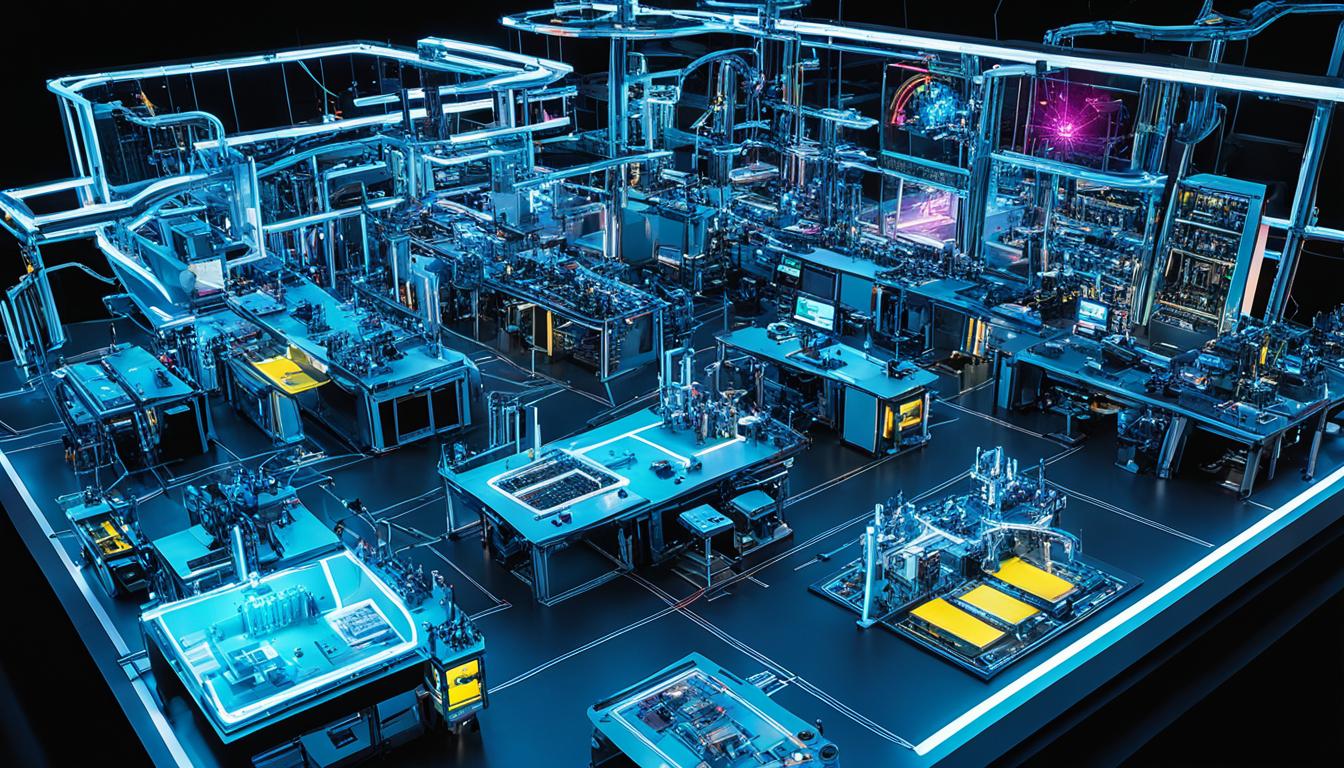
The world of nanotechnology is rapidly evolving, ushering in a new era of groundbreaking advancements that are poised to reshape various industries by 2025. From innovative nanomaterials and cutting-edge nanorobotics to revolutionary nanoelectronics and transformative nanobiotechnology breakthroughs, the future of this transformative technology holds immense promise. Prepare to be amazed as we explore the latest nanotechnology innovations that are anticipated to make a significant impact in the years ahead.
According to a recent study by Grand View Research, Inc., the global market for healthcare nanotechnology is expected to reach a staggering $196.02 billion by 2020, growing at a remarkable CAGR of 12.1%. This remarkable growth underscores the profound impact that nanotechnology is having, particularly in the healthcare sector. From enabling innovative drug delivery methods to facilitating early disease detection through nanosensors, and even empowering targeted cancer treatment using nanobots, the possibilities are truly endless.
As the nanotechnology landscape continues to evolve, governments and regulatory bodies, such as the FDA, are working diligently to provide the necessary guidance and oversight to ensure the responsible development of these groundbreaking nanotechnology products. Across various industries, companies are recognizing the immense value of incorporating nanotechnology into their products and services, as it allows them to stay competitive and at the forefront of innovation.
The synergy between nanotechnology and medicine holds the potential to introduce transformative innovations in the fight against a wide range of diseases. By harnessing the power of this remarkable technology, we can look forward to a future where the unimaginable becomes a reality, and the boundaries of what is possible are constantly pushed.
Key Takeaways
- The global healthcare nanotechnology market is expected to reach $196.02 billion by 2020, growing at a CAGR of 12.1%.
- Nanotechnology is revolutionizing industries, including healthcare, by enabling innovative drug delivery methods, early disease detection, and targeted cancer treatment.
- The FDA is providing regulatory guidance to ensure the responsible development of nanotechnology products.
- Companies are increasingly incorporating nanotechnology into their products and services to stay competitive.
- The combination of nanotechnology and medicine has the potential to introduce transformative innovations in the fight against various diseases.
Nanotechnology Revolutionizing Healthcare
The revolutionary advancements in nanoparticles, nanosensors, and nanobots are transforming the healthcare industry, ushering in a new era of more efficient and targeted drug delivery, early disease detection, and precision cancer treatment.
Nanoparticles for Drug Delivery
Nanoparticles, with their unique physicochemical properties, are enabling more efficient and targeted drug delivery. Nanoparticle-based drug formulations can cross physical barriers, such as the blood-brain barrier, to deliver medications to specific sites in the body. This increases the efficacy and reduces the side effects of various drugs, particularly in the treatment of chronic diseases and cancer. Johnson & Johnson has utilized Elan’s nanocrystal technology to develop an injectable formulation of Paliperidone palmitate, a drug for schizophrenia, which overcomes the insolubility of the drug by reducing the particle size to under 200 nm.
Nanosensors for Early Disease Detection
Nanosensors, made of materials on the nanoscale, are revolutionizing the field of disease diagnosis and monitoring. These highly sensitive and miniaturized sensors can detect biomarkers and other indicators of disease at the earliest stages, allowing for more effective and timely interventions. Nanosensors have the potential to transform the way various diseases, including cancer, cardiovascular conditions, and neurological disorders, are detected and managed.
Nanobots for Targeted Cancer Treatment
Researchers are developing nanobots, or nanorobots, that can be programmed to target and treat cancer cells with precision. These microscopic devices can be designed to deliver drugs, perform surgical procedures, or even directly attack tumor cells. The ability of nanobots to navigate the human body and interact with cells at the cellular and molecular level holds great promise for more effective and less invasive cancer treatments. Companies like NanoPharm in Germany have developed nanoparticle-based systems capable of reaching the brain to deliver cancer drugs and other therapeutic agents.
What are the latest breakthroughs in nanotechnology anticipated by 2025?
Nanoelectronics and Quantum Computing
Advancements in nanoelectronics and quantum computing are expected to revolutionize various industries by 2025. Nanoelectronics, which involves the manipulation of matter at the nanoscale to create ultra-small electronic components, can enable faster, more energy-efficient, and more powerful computing devices. Meanwhile, quantum computing, which utilizes the principles of quantum mechanics, has the potential to solve complex problems that are intractable for classical computers. Google’s Quantum AI Laboratory predicts that small-scale quantum technologies will be commercially available within the next five years, helping businesses increase revenue, reduce costs, and lower infrastructure investments.
Nanomaterials for Energy Storage
Nanomaterials are being developed to enhance energy storage and efficiency, paving the way for advancements in renewable energy technologies. Nanoscale materials can be engineered to have unique properties that improve the performance of batteries, supercapacitors, and other energy storage devices. These innovations can lead to longer-lasting, faster-charging, and more efficient energy storage solutions, which are crucial for the widespread adoption of electric vehicles and the integration of intermittent renewable energy sources, such as solar and wind, into the power grid.

Nanotechnology in Defense and Security
Nanotechnology has the potential to revolutionize the world of defense and national security, with advancements in areas such as nanoweapons, advanced explosives, nanosensors for chemical and biological threat detection, and nanomaterials for stealth and camouflage technologies. As this transformative technology continues to evolve, it is crucial to understand both the opportunities and the potential risks associated with its military applications.
Nanoweapons and Advanced Explosives
Researchers have already demonstrated the use of nanomaterials to create more powerful and efficient explosives, such as the “Father of All Bombs” developed by Russia, which utilizes nanotechnology-enabled explosives. There are also concerns about the convergence of nanotechnology with other emerging technologies, such as biotechnology and synthetic biology, potentially leading to the creation of new types of biological weapons. Military spending on nanotechnology research has been reported in several countries, including China, Russia, and Iran, as they seek to gain strategic advantages through these advanced technologies.
Nanosensors for Chemical and Biological Threat Detection
Nanosensors are being developed for the detection of chemical and biological threats, enhancing national security and homeland defense capabilities. These miniaturized sensors can be designed to identify the presence of hazardous substances, pathogens, and other potential threats with high sensitivity and accuracy. Nanotechnology is enabling the creation of more efficient and reliable detection systems that can be deployed in various settings, from military operations to public spaces, to provide early warning and protect against chemical and biological attacks.
Nanomaterials for Stealth and Camouflage
Nanomaterials are being leveraged to develop advanced stealth and camouflage technologies for military applications. By engineering materials with unique properties at the nanoscale, researchers can create surfaces and coatings that can absorb or scatter light, infrared, and other forms of electromagnetic radiation, making objects more difficult to detect. These nanomaterials-based stealth and camouflage solutions have the potential to enhance the survivability and effectiveness of military personnel and equipment in various operational environments.
Conclusion
As we’ve explored, nanotechnology is poised to revolutionize numerous industries, including healthcare, energy, and defense, by the year 2025. Breakthroughs in areas such as nanoparticle-based drug delivery, nanosensors for early disease detection, nanoelectronics and quantum computing, and nanomaterials for energy storage and military applications are expected to have a significant impact on our lives.
However, the rapid progress in nanotechnology also raises concerns about its potential misuse for the development of nanoweapons and other security threats. Governments and regulatory bodies, such as the FDA, are working diligently to ensure the responsible and transparent development of nanotechnology, allowing us to harness its benefits while mitigating the risks.
As this transformative technology continues to evolve, it is crucial for stakeholders, including industry leaders, policymakers, and the public, to remain vigilant, foster collaboration, and cultivate the necessary talent to navigate the challenges and opportunities presented by nanotechnology. By doing so, we can unlock the full potential of this field and realize the positive impact it can have on our society and the world around us.
FAQ
What is the expected growth of the global healthcare nanotechnology market by 2020?
The global market for healthcare nanotechnology is expected to reach 6.02 billion by 2020, growing at a CAGR of 12.1%, according to a new study by Grand View Research, Inc.
How is nanotechnology transforming the healthcare industry?
Nanotechnology is revolutionizing healthcare by enabling innovative drug delivery methods, early disease detection through nanosensors, and targeted cancer treatment using nanobots. The FDA is providing regulatory guidance to ensure the responsible development of nanotechnology products.
How are nanoparticles improving drug delivery?
Nanoparticles, with their unique physicochemical properties, are enabling more efficient and targeted drug delivery. Nanoparticle-based drug formulations can cross physical barriers, such as the blood-brain barrier, to deliver medications to specific sites in the body, increasing efficacy and reducing side effects.
How are nanosensors transforming disease detection and monitoring?
Nanosensors, made of materials on the nanoscale, are revolutionizing the field of disease diagnosis and monitoring. These highly sensitive and miniaturized sensors can detect biomarkers and other indicators of disease at the earliest stages, allowing for more effective and timely interventions.
What are the potential applications of nanobots in cancer treatment?
Researchers are developing nanobots, or nanorobots, that can be programmed to target and treat cancer cells with precision. These microscopic devices can be designed to deliver drugs, perform surgical procedures, or even directly attack tumor cells, promising more effective and less invasive cancer treatments.
What advancements in nanoelectronics and quantum computing are expected by 2025?
Advancements in nanoelectronics and quantum computing are expected to revolutionize various industries by 2025. Nanoelectronics can enable faster, more energy-efficient, and more powerful computing devices, while quantum computing has the potential to solve complex problems intractable for classical computers.
How are nanomaterials being used to enhance energy storage and efficiency?
Nanomaterials are being developed to enhance energy storage and efficiency, paving the way for advancements in renewable energy technologies. Nanoscale materials can be engineered to have unique properties that improve the performance of batteries, supercapacitors, and other energy storage devices.
What are the concerns regarding the potential misuse of nanotechnology for weapons development?
Nanotechnology has the potential to be weaponized, leading to the development of nanoweapons and advanced explosives. There are also concerns about the convergence of nanotechnology with other emerging technologies, such as biotechnology and synthetic biology, potentially leading to the creation of new types of biological weapons.
How are nanosensors being used for chemical and biological threat detection?
Nanosensors are being developed for the detection of chemical and biological threats, enhancing national security and homeland defense capabilities. These miniaturized sensors can be designed to identify the presence of hazardous substances, pathogens, and other potential threats with high sensitivity and accuracy.
What are the advancements in nanomaterials for stealth and camouflage technologies?
Nanomaterials are being leveraged to develop advanced stealth and camouflage technologies for military applications. By engineering materials with unique properties at the nanoscale, researchers can create surfaces and coatings that can absorb or scatter light, infrared, and other forms of electromagnetic radiation, making objects more difficult to detect.
